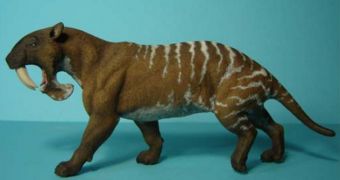About 3.5 million years ago, a super-predator known to scientists as Thylacosmilus atrox was scaring the life out of whatever creatures happened to share its natural habitat in present day South America.
If only these creatures had known that, fierce looks aside, this super-predator had a bite less powerful than that of cats people presently keep as pets.
Paleontologists explain that, though it had a really impressive set of sabre-like teeth, Thylacosmilus atrox could not really take pride in its jaw muscles.
“Frankly, the jaw muscles of Thylacosmilus were embarrassing. With its jaws wide open this 80-100 kg [roughly 186-220 pounds] ‘super-predator’ had a bite less powerful than a domestic cat,” Dr. Stephen Wroe says.
Specialists suspect that, in order to secure its next meal, this carnivore had to use its strong forelimbs to immobilize the prey.
Once the prey was pinned to the ground, Thylacosmilus atrox would use its neck muscles to drive its teeth into the victim's windpipe or major arteries.
“Bottom line is that the huge sabres of Thylacosmilus were driven home by the neck muscles alone and – because the sabre-teeth were actually quite fragile – this must have been achieved with surprising precision. For Thylacosmilus – and other sabre-tooths – it was all about a quick kill,” Dr. Stephen explains.

 14 DAY TRIAL //
14 DAY TRIAL //